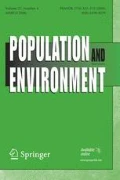Demographic dynamics shape so very many aspects of social life—while also having important environmental dimensions. This issue of Population and Environment includes research on three widely varied connections between demographic dynamics and environment including: land use and cover change (Carr et al. 2009), conservation of endangered species (Heinen and Shrivastava 2009), as well as emission of pollutants (Squalli 2009). In addition, a policy essay offers critical commentary on links between population, reproductive health and climate change (Petroni 2009).
Many regions of Central and South America have witnessed the recent loss of large forest areas. To shed light on the demographic dimensions of this land use change, Carr et al. (2009) examine the bivariate association between changes in population patterns and land use over a 3-decade period. This piece, entitled “The Population, agriculture, and environment nexus in Latin America: Country-level evidence from the latter half of the 20th century”, provides an important addition to recent work also published in Population and Environment on these dynamics within the Latin American setting (e.g. Bremner et al. 2009; Carr 2004; Carr et al. 2006; Gray 2009). Carr et al.’s hypotheses are grounded within classical theoretical frameworks from Boserup (1965), Davis (1963) and Bilsborrow (1987) and their analyses shed light on the ways in which these associations differentially unfold in particular settings. Interestingly, their work suggests that the land cover changes occurring in Central and South America have emerged from settings with dissimilar initial population densities and demographic trajectories. Discussion of the challenges posed by these distinctions for policy and research conclude their contribution.
Next, research in this issue contributes to scientific knowledge surrounding the contentious policy issue of immigration. With a focus on a subset of U.S. counties, Squalli (2009) presents a quantitative analysis inspired by the STIRPAT conceptual framework (Dietz and Rosa 1994). The article is entitled “Immigration and Environmental Emissions: A U.S. County-Level Analysis” and makes use of a combination of data from the U.S. Census Bureau and the Environmental Protection Agency. Squalli models emissions of four common air pollutants as associated with county-level population composition, focusing on the presence of native-born and foreign-born residents. Although data limitations constrain the analysis, Squalli argues that the results underscore the importance of careful examination of this association. He further argues that this initial analysis should provide a useful foundation for future research.
The final research presentation in this issue delves into the connection between demographic dynamics, development and resource management initiatives. Entitled “An analysis of conservation attitudes and awareness around Kaziranga National Park, Assam, India: Implications for conservation and development”, Heinen and Shrivastava’s (2009) research is situated in India—a fascinating setting for this work since India is a nation of important biodiversity as well as some of the highest rural human population densities on Earth. Heinen and Shrivastava report on the first in-depth socio-economic study of the biologically significant Kaziranga National Park—involving interviews of 590 households in 37 villages. Their findings reveal important distinctions in awareness and perceptions of conservation initiatives across demographic groups (e.g. by caste, ethnicity)—insights which should inform development and conservation policy and programs.
Finally, this issue concludes with a “Policy Essay” entitled “Ethical aspects of making the ‘population growth-climate change’ connection.” Population and Environment is committed to publishing only well-crafted, well-researched essays and this submission has met that criteria. Petroni (2009) offers an overview of arguments on the population–climate change connection and offers discussion of the underlying ethical issues involved in advancing an advocacy argument around increasing family planning as a way to slow population growth and mitigate climate change. Such considerations are of particular import as the global community considers the next round of climate negotiations at the Climate Conference in Copenhagen.
Again, I thank all of the authors in this issue for their devotion to the production of high quality scholarship linking population and environmental issues. I also thank the reviewers who aided in improving these manuscripts through their critical commentary.
To all scholars, consider the implications of Copenhagen as you consider important arenas of future research on the human dimensions of global environmental change!
References
Bilsborrow, R. E. (1987). Population pressures and agricultural development in developing countries: A conceptual framework and recent evidence. World Development, 15(2), 183–203.
Boserup, E. (1965). Population and technological change: A study of long-term trends. Chicago: The University of Chicago Press.
Bremner, J., Bilsborrow, R., Feldacker, C., & Holt, F. L. (2009). Fertility beyond the frontier: Indigenous women, fertility and reproductive practices in the Ecuadorian Amazon. Population and Environment, 30(3), 93–113.
Carr, D. L. (2004). Proximate population factors and deforestation in tropical agricultural frontiers. Population and Environment, 25(6), 585–612.
Carr, D. L., Lopez, A. C., & Bilsborrow, R. E. (2009). The population, agriculture, and environment nexus in Latin America: Country-level evidence from the latter half of the twentieth century. Population and Environment. doi:10.1007/s11111-009-0090-4.
Carr, D. L., Pan, W. K. Y., & Bilsborrow, R. E. (2006). Declining fertility on the frontier: The Ecuadorian Amazon. Population and Environment, 28(1), 17–39.
Davis, K. (1963). The theory of change and response in modern demographic history. Population Index, 29(4), 345–366.
Dietz, T., & Rosa, E. A. (1994). Rethinking the environmental impacts of population, affluence and technology. Human Ecology Review, 1, 277–300.
Gray, C. L. (2009). Rural out-migration and smallholder agriculture in the southern Ecuadorian Andes. Population and Environment, 30(4–5), 193–217.
Heinen, J. T., & Shrivastava, R. J. (2009). An analysis of conservation attitudes and awareness around Kaziranga National Park, Assam, India: Implications for conservation and development. Population and Environment. doi:10.1007/s11111-009-0086-0.
Petroni, S. (2009). Policy review: Thoughts on addressing population and climate change in a just and ethical manner. Population and Environment. doi:10.1007/s11111-009-0085-1.
Squalli, J. (2009). Immigration and environmental emissions: A U.S. county-level analysis. Population and Environment. doi:10.1007/s11111-009-0089-x.
Author information
Authors and Affiliations
Corresponding author
Rights and permissions
About this article
Cite this article
Hunter, L.M. Editor’s introduction. Popul Environ 30, 219–221 (2009). https://doi.org/10.1007/s11111-009-0098-9
Published:
Issue Date:
DOI: https://doi.org/10.1007/s11111-009-0098-9

